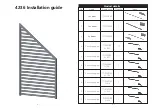
Wiring
Guidelines
Don't:
•
make sharp bends in the cables
•
run cables in a way that allows water to flow down into the connectors
•
run the data cables adjacent to radar, transmitter, or large/high current carrying cables or
high frequency signal cables.
•
run cables so they interfere with mechanical systems
•
run cables over sharp edges or burrs
Do this:
•
make drip and service loops
•
use cable-tie on all cables to keep them secure
•
solder/crimp and insulate all wiring connections if extending or shortening the cables.
Extending cables should be done with suitable crimp connectors or solder and heat
shrink. Keep joins as high as possible to minimize possibility of water immersion.
•
leave room adjacent to connectors to ease plugging and unplugging of cables
Warning:
Before starting the installation, be sure to turn electrical power
off. If power is left on or turned on during the installation, fire, electrical
shock, or other serious injury may occur. Be sure that the voltage of the
power supply is compatible with the unit.
Warning:
The positive supply wire (red) should always be connected to
(+) DC with the supplied fuse or a circuit breaker (closest available to fuse
rating).
Power connection
The unit is designed to be powered by a 12 or 24 V DC system. It is protected against reverse
polarity, under voltage and over voltage (for a limited duration).
A fuse should be fitted to the positive supply; 3 A for the 7” and 9” units, and 5 A for the 12”
and 16” units.
3
4
1
2
Unit socket
(male)
1
2
3
4
Cable plug (female)
Key
Purpose
Color
1
DC negative
Black
2
External alarm
Blue
3
Power control
Yellow
4
+12/24 V DC
Red
Power Control connection
Ú
Note:
If the control unit is set to Power Slave, the unit cannot be powered down using
its own power key. Presseing and holding this key will set the unit to standby. Refer to
"Power Control"
on page 24.
4
Wiring
| NSS evo3 Installation Manual
15















































